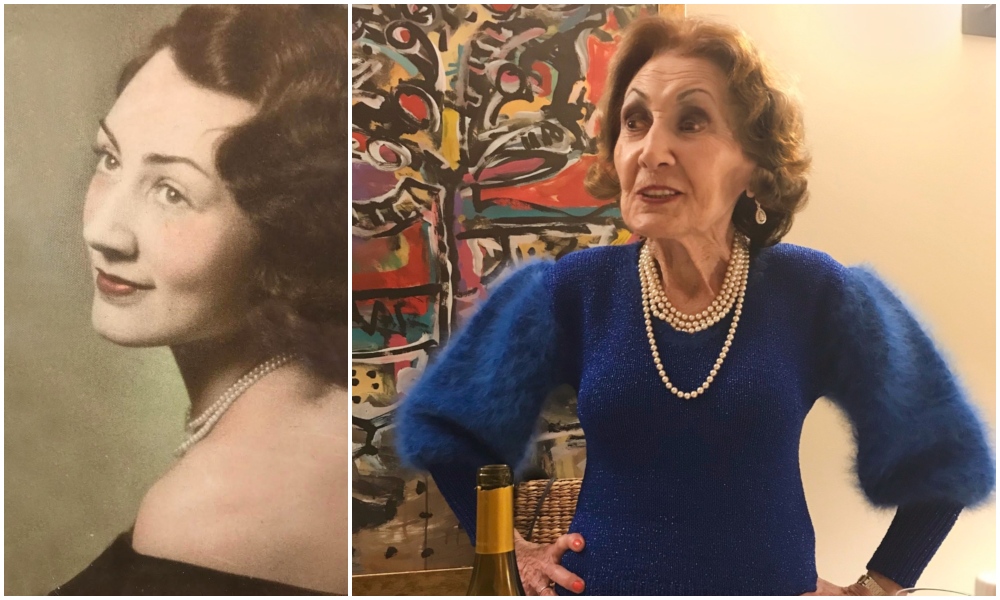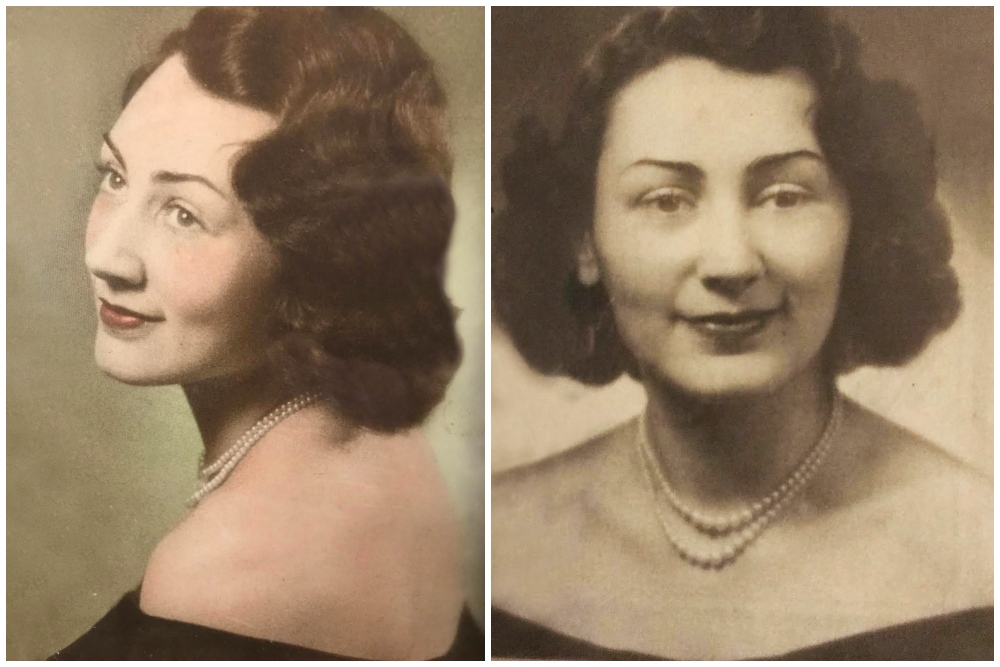
We checked in with Helena to see how she’s doing during the pandemic. Read the story here.
An elegant lady of 95 walked in to my friend’s Upper West Side apartment on the second night of Passover. She had an aristocratic air. All eyes were on her, coiffed in auburn waves, wearing strings of pearls above a vibrant sapphire blue sweater. “What a beautiful sweater!” I told her. She was quick to tell me she wore it every Passover. The sweater also came with a story. Little did I know that Helena’s story—a tale of persecution, survival and liberation—echoed the story of Passover. Fortunately both had happy endings.
The story starts in Dusseldorf, Germany in 1924, when Helena Weinstock Weinrauch was born to a pianist mother and an engineer father. The family moved to Poland a few years later when her father accepted a position offered by the Polish government. For the next decade, life was good and they prospered. But all that changed in 1939.
After a brief occupation by the Germans, the Russians arrived. Well-to-do people, suspected capitalists, were threatened with exile to Siberia. Helena’s parents and older sister Erna, were forced into hiding. But 16-year-old Helena stayed to get her diploma while working part-time in an office. She’d get up at 5 a.m. to wait on a food line, go to work and then to school until 9 p.m.

Helena at Passover. (All photos courtesy of Helena Weinstock Weinrauch)
A year later her parents returned and the Weinstocks were reunited, though it would be short-lived. The Nazis marched back in and restrictions on Jews got harsher. One day, while Helena was at work, 300 Jewish families were rounded up—including her parents and older sister. Helena never saw them again.
It was her boss who became her hero, risking his life to get her counterfeit German papers. She was a purebred Aryan woman according to her new documents, weaving a story that her fiancée was on the German front fighting. With a new identity, she left for Krakow and the home of her boss’ friends. To them, she was a pretty, young German girl. They even included her in a social event where she found herself nervously dancing in the arms of a Nazi officer, a dance that would later save her life. But her German disguise didn’t last long. Hurrying down a street one morning, she was recognized by a former classmate who turned her in to the Gestapo.
And so began a terrifying chapter. The Gestapo, desperate to know the originator of her fake papers, beat and tortured her almost to death. But she never yielded and soon faced a firing squad. Fate intervened when the Nazi officer she had danced with recognized her on the firing line and halted the execution. Humiliated that he had been deceived by this Jewish girl, he condemned her to what he believed was a life worse than death, a concentration camp.

She was sent to Plaszow, an interim stop before Auschwitz, the camp from which Oskar Schindler saved Jewish lives with his list. Helena was not on that list. Nevertheless, her life was spared once again from a second firing squad. A young Jewish policeman, indebted to her for helping his sister, arrived just in time to save her.
By the winter of 1944, the Germans evacuated Auschwitz forcing prisoners on the infamous Death March to Bergen-Belsen. It was three weeks of walking 500 miles in below freezing temperatures, wearing only a camp uniform. There was one blanket for four people. “I tore the blanket into fours and covered my feet,” Helena explained. She was one of the lucky ones who survived the brutal walk—though barely. When the British Army liberated Bergen-Belsen on April 15, 1945, Helena was mistaken for dead until an officer realized her 60 pound body was still warm.
The British put Helena on a Red Cross relief ship bound for a hospital near Stockholm in Sigtuna, Sweden. “I will never forget the Swedish people as long as I live,” Helena commented. “They took in 6,000 survivors and cared for us selflessly. They restored my faith in humanity.”
In the hospital, Helena met another Auschwitz survivor, Ann Rothman, a master knitter. In the Lodz ghetto Ann had knitted dresses, skirts and sweaters for the wives of German officers who supplied the wool that Jews could no longer buy. Her knitting needles saved her life.
In the hospital, Ann continued to knit for the nurses, doctors and fellow patients. For Helena, Ann created a vibrant sapphire blue sweater that 75 years later dazzled everyone at the seder table. Helena recalled, “Ann told me, although we have no home, no family, no money, we still have Pesach and the memory of our families. Then Ann handed me this blue sweater that she had just finished.” The price: Helena must wear it on Pesach. “Instead of afikomen treats or chocolates, I got a sweater!” Helena laughs. She has worn it every Passover since.
The sweater accompanied Helena to New York in 1947, a trip sponsored by her uncle. She and Ann, also in New York, remained lifelong friends. Helena married Joseph Weinrauch and with their daughter settled on Manhattan’s Upper West Side. Unfortunately, she lost both her husband and daughter and now lives alone.

Helena volunteers for the blind and lectures in schools about hatred and bigotry. At 87 she started ballroom dancing, which has become her passion. “As long as I can walk, I’ll dance,” she vows.
Her real secret for staying young, Helena says, is indulging in cheese, eggs and dark chocolate. “After starving for years, I promised myself that if I survived, I’d eat whatever I wanted,” she said. Aglow in her sapphire blue sweater that seder night, Helena reached for a piece of dark chocolate almond bark and beamed at the table. Ninety-five years old, and everyone was in love with her.
Dayenu.

14 thoughts on “The Girl in the Blue Sweater”
Beautiful story Gail. So glad you got to share it with the world. I hope she will wear her gorgeous sweater for many more Pesachs. Does she have someone to leave it to? Perhaps one of the Jewish history museums would love it to share with her story for the ages.
I think Helena will be leaving her sweater to the Holocaust Museum in D.C.
Stories out of the blue such as Gail’s incredibly eloquent written tale about what our people endured are reminders of this unthinkable time and unthinkable human inflicted misery. So easy to forget and as time passes, it is so critical, though so painful, that stories of cruelty and about acts of goodness and kindness be preserved and passed to those who come later and inherit the power to choose between delivery of misery or delivery of humanity. Thanks for this great story!
What a lady! and what a story! the sweater is simply stunning, as is she! Inspirational!
A Must Read!
I came across this remarkable story via a rather long winded route that led me to Gail’s FB page and then to this article. A remarkable story, beautifully told. Hope someone has filmed this incredible lady for posterity. “The Blue Sweater” is a book/film in the making. Thanks for sharing the story Gail.
To think that many in today’s world believe that this atrocious time in history never happened.
“Know thy history. Let it horrify you; let it inspire you. Let it show you how the future can look, for nothing in this world has not come around before. Voices demanding to be heard, to impart the hard-earned wisdom of a tangled, difficult, complicated history; we just try to open the door and let them through.”
Rhiannon Giddens
Helena is well known in Corning, NY for speaking to local middle school students several years ago. Her husband Joe’s sister, Meta Spiegler, also a Holocaust survivor, started a program for students to learn about the Holocaust from survivors. Helena is fondly remembered and loved by many of these students.
Thanks to Moment Magazine for a beautiful story about a courageous woman.
This story renews ones faith in humanity. An amazing woman, a cherished blue sweater and an excellent story teller! (I am a friend of KK’s)
My parents were both Holocaust survivors but didn’t speak about their experiences. I now watch survivors testimonials on YouTube to get a understanding of what they went thru, both are no longer alive. She is a remarkable women, like all the survivors.
This is an profoundly moving story! Thank you!
Wishing a blessed Passover, indeed, to Helena. I see God’s hand in Sweden that inspired the Swedish to care for her so selflessly. I pray Helena does also!
Whenever life throws me curves I think about those people, like Helena, and what they went through; and yet there she is smiling broadly and
dancing!!! What an inspiration!
This story was so powerful it inspired me to write a poem. If there’s a way to send the poem to you and/or Helena please contact me. Thank you.